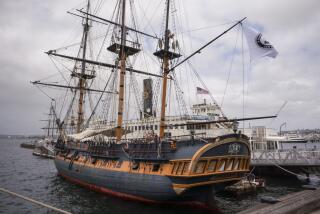Untold Tales: Adventures of Two Schooners
I will use any excuse to tell a good sea story, including a confession that one I told previously wasn’t quite true.
In writing about our New England tour, I said that as we rolled through Wiscasset, Me., we saw two old schooners rotting in the harbor. Our tour guide Jeanne Eagleson told us that the two ships had been built just before the advent of steam, and had never sailed.
This melancholy story prompted me to note an ironic similarity of fates between the schooners and a nuclear plant we had seen earlier that day near Seabrook, N. H.
Because of public hostility, Eagleson told us, it had never been used. Thus, I pointed out, both the schooners and the power plant had been victims of bad timing: The schooners had been built too late, the power plant too soon.
But Charles W. Earnshaw of South Pasadena sends me a leaflet on “The Wiscasset Ships,” by E. Michael Roy, that reveals that the two ships--Hesper and Luther Little--had numerous adventures before they were abandoned to decay.
The Luther Little, he writes, was launched on Dec. 17, 1917, and sailed during World War I not only as a coaster but also in deep water, “reaping fine profits” for her owners.
Roy recalls that she was a beautiful four-master, with lines like those of the clipper ships. “Her after cabin was paneled in natural oak, and there were steam engines to hoist her anchor and sails.”
Her finest hour, perhaps, was in June, 1918, when she rescued two balloonists and their balloon off the coast of Delaware. In July, 1920, deep loaded with logs, she was stuck hard and fast for nearly two weeks near the mouth of a Haitian harbor. She continued in service until she was laid up in the 1920s. In 1932 she was auctioned to satisfy claims against her, and never sailed again.
Roy notes: “Though she was still in good condition she was laid up at Wiscasset, a victim of the growing lack of call for ships of her type, and because of the increasing difficulty in securing a crew to sail her.”
The Hesper was launched on Aug. 23, 1918, and she, too, had an adventurous career. She made two voyages to Lisbon with coal, and sailed down to Venezuela for a load of guano. In the winter of 1920 she left Norfolk with a load of coal, but a severe storm stripped her canvas and drove her far off course. Nine days later she made Portland, Me., where she had to wait for new sails from Boston.
Five years later Hesper went aground in Boston harbor with a full load of lumber; it took nine tugs to pull her free. In the mid-’20s she was laid up at Rockport, where a January snowstorm drove her clean through her wharf, scattering planks and pilings and wrecking the pier. She was moved to Portland, where she was long a familiar sight, but finally, like the Luther Little, she was sold at auction, for $600, to satisfy claims against her, and was moved to Wiscasset to die alongside her sister.
Roy deplores the neglect of these two beautiful relics from another age. “It is a shame to let them fall apart, because, though many don’t realize it, they are a living link to our past. . . . We should save our priceless antiques for future generations to admire. We are losing our history that can be ‘touched,’ for a few memories and old worn photographs.”
I do not chide Eagleson for her error. I suspect that most historical notes passed on by tour guides are more legend than fact, and none the less entertaining for that.
Besides, Eagleson was right in a sense. She had the names of the two ships correct, and she was right in saying that they had not been able to compete with steam. However, she denied them the few years of service they had, and the adventures they encountered.
Perhaps she will see this column and pass it on to her colleagues in Tauck Tours, so that future busloads of tourists will be informed, as they pass the two hulks rotting on the rocks, that they did live briefly before they died.
More to Read
Sign up for The Wild
We’ll help you find the best places to hike, bike and run, as well as the perfect silent spots for meditation and yoga.
You may occasionally receive promotional content from the Los Angeles Times.






